1608 Louvre Henri IV /Fleur-de-lis Royal French heraldry Art Nouveau XBig medal

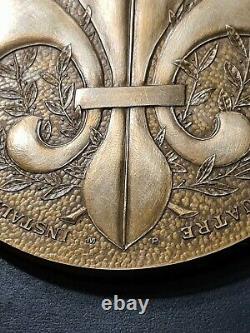
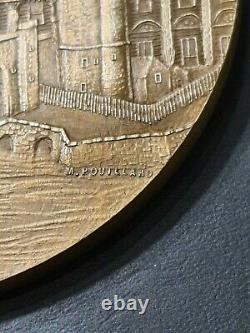
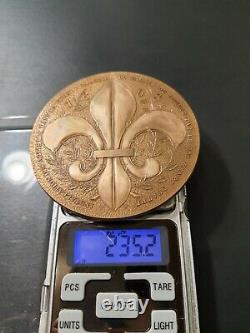
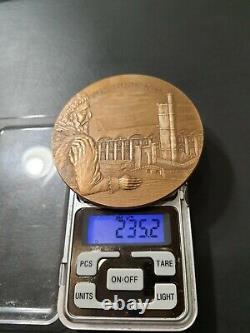
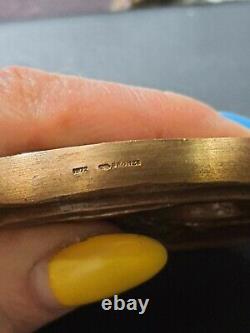
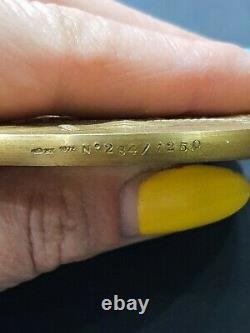

The Louvre Palace French: Palais du Louvre, pal? , often referred to in French simply as Louvre, is an iconic building of the French state located on the Right Bank of the Seine in Paris, occupying a vast expanse of land between the Tuileries Gardens and the church of Saint-Germain l'Auxerrois. Originally a military facility, it has served numerous government-related functions in the past, including intermittently as a royal residence between the 14th and 18th centuries. It is now mostly used by the Louvre Museum, which first opened there in 1793.
Whereas the area had been inhabited for thousands of years, [1] the Louvre's history starts around 1190 with its first construction as a fortress defending the western front of the Wall of Philip II Augustus. The Louvre's oldest section still standing above ground, its Lescot Wing, dates from the late 1540s, when Francis I started the replacement of the medieval castle with a new design inspired by classical antiquity and Italian Renaissance architecture. Most parts of the current building were constructed in the 17th and 19th centuries.
For more than three centuries, the history of the Louvre has been closely intertwined with that of the Tuileries Palace, created to its west by Catherine de' Medici in 1564 and finally demolished in 1883. The Tuileries was the main seat of French executive power during the last third of that period, from the return of the King and his court from Versailles in October 1789 to the Paris Commune which decided to burn it down in its final days in May 1871. The Pavillon de Flore and Pavillon de Marsan, which used to respectively mark the southern and northern ends of the Tuileries, are now considered part of the Louvre Palace.
The Carrousel Garden, first created in the late 19th century in what used to be the great courtyard of the Tuileries (or Cour du Carrousel), is now considered part of the Tuileries Garden. Besides the world-class status of the eponymous museum, the Louvre Palace stands apart in Paris, France and even Europe, for its uniquely rich history and the multiple layers of legacy thereof that have been preserved to this day. In 1924, the Baedeker guide to Paris called it the largest and most splendid palace in the world. Henry IV (French: Henri IV; 13 December 1553 - 14 May 1610), also known by the epithet Good King Henry or Henry the Great, was King of Navarre (as Henry III) from 1572 and King of France from 1589 to 1610.He was the first monarch of France from the House of Bourbon, a cadet branch of the Capetian dynasty. He was assassinated in 1610 by François Ravaillac, a fanatical Catholic, and was succeeded by his son Louis XIII. The son of Antoine de Bourbon, Duke of Vendôme and Jeanne d'Albret, the Queen of Navarre, Henry was baptised as a Catholic but raised in the Protestant faith by his mother.
He inherited the throne of Navarre in 1572 on his mother's death. As a Huguenot, Henry was involved in the French Wars of Religion, barely escaping assassination in the St. He later led Protestant forces against the royal army. He and his predecessor Henry III of France were direct descendants of Saint-King Louis IX. Henry III belonged to the House of Valois, descended from Philip III of France, elder son of Saint Louis; Henry IV belonged to the House of Bourbon, descended from Robert, Count of Clermont, younger son of Saint Louis.
As Head of the House of Bourbon, Henry was "first prince of the blood". Upon the death of his brother-in-law and distant cousin Henry III in 1589, Henry was called to the French succession by the Salic law. He initially kept the Protestant faith (the only French king to do so) and had to fight against the Catholic League, which denied that he could wear France's crown as a Protestant. After four years of stalemate, he converted to Catholicism to obtain mastery over his kingdom reportedly saying, Paris is well worth a mass. As a pragmatic politician (in the parlance of the time, a politique), he displayed an unusual religious tolerance for the era.
Notably, he promulgated the Edict of Nantes (1598), which guaranteed religious liberties to Protestants, thereby effectively ending the Wars of Religion. Considered a usurper by some Catholics and a traitor by some Protestants, Henry became the target of at least 12 assassination attempts. [3] Having faced much opposition during his reign, Henry gained more status after his death. [4] He was admired for his repeated victories over his enemies and his conversion to Catholicism. "Good King Henry" (le bon roi Henri) was remembered for his geniality and his great concern about the welfare of his subjects.
[2] An active ruler, he worked to regularise state finance, promote agriculture, eliminate corruption and encourage education. During his reign, [5] the French colonization of the Americas truly began with the foundation of the colonies of Acadia and Canada at Port-Royal and Quebec, respectively.
He was celebrated in the popular song "Vive le roi Henri" (which later became an anthem for the French monarchy during the reigns of his successors) and in Voltaire's Henriade. This item is in the category "Coins & Paper Money\Exonumia\Medals".
The seller is "top-art-medals" and is located in this country: IL. This item can be shipped worldwide.

